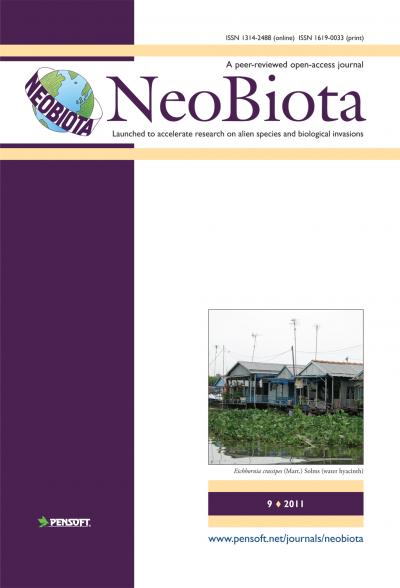Comparative原生欧洲和外来蓬托-里海片脚类动物的有丝分裂基因组学
IF 3
2区 环境科学与生态学
Q1 BIODIVERSITY CONSERVATION
引用次数: 0
摘要
欧洲内陆地表水是丰富多样的本地片脚类甲壳类动物的家园,其中许多都面临着来自入侵的蓬托-里海同类的威胁。在这项研究中,我们分析了线粒体基因组来推断系统发育关系,并比较了5科、10属和20种(其中13种是新测序的)具有代表性的欧洲本土和入侵的蓬托-里海分类群的基因顺序和核苷酸组成。我们观察到不同的基因重排模式在系统发育不同的本地物种池。四足Pallaseopsis quadrispinosa和山缕草(Synurella ambulans)表现出与典型组织的显著差异,其特征是trna和nad1基因的广泛易位,以及后者的tRNA-F极性开关。单系入侵的Ponto-Caspian gammarids表现出保守的基因序列,主要与本地物种的tRNA-E和tRNA-R易位不同,这加强了先前的研究结果。然而,Chaetogammarus warpachowskyi表现出广泛的重排,6个trna易位。入侵的corophhium Chelicorophium curvispinum,尽管其系统发育位置较远,但仍保持着高度保守的基因序列。我们还发现,与入侵种相比,本地种的GC含量明显高于入侵种,AT含量明显低于入侵种。观察到的本土和入侵片脚类之间的有丝分裂基因组差异值得进一步研究,并可能为入侵成功的机制提供见解。本文章由计算机程序翻译,如有差异,请以英文原文为准。
Comparative mitogenomics of native European and alien Ponto-Caspian amphipods
European inland surface waters are home to a rich diversity of native amphipod crustaceans, many of which face threats from invasive Ponto-Caspian counterparts. In this study, we analyse mitochondrial genomes to deduce phylogenetic relationships and compare gene order and nucleotide composition between representative native European and invasive Ponto-Caspian taxa across five families, ten genera and 20 species (with 13 newly sequenced herein). We observe various gene rearrangement patterns in the phylogenetically diverse native species pool. Pallaseopsis quadrispinosa and Synurella ambulans exhibit notable deviations from the typical organisation, featuring extensive translocations of tRNAs and the nad1 gene, as well as a tRNA-F polarity switch in the latter. The monophyletic invasive Ponto-Caspian gammarids display a conserved gene order, primarily differing from native species by a tRNA-E and tRNA-R translocation, which reinforces previous findings. However, Chaetogammarus warpachowskyi shows extensive rearrangement with translocations of six tRNAs. The invasive corophiid, Chelicorophium curvispinum, maintains a highly conserved gene order despite its distant phylogenetic position. We also discover that native species have a significantly higher GC and lower AT content compared to invasive species. The mitogenomic differences observed between native and invasive amphipods warrant further investigation and could provide insights into the mechanisms underlying invasion success.
求助全文
通过发布文献求助,成功后即可免费获取论文全文。
去求助
来源期刊

Neobiota
Agricultural and Biological Sciences-Ecology, Evolution, Behavior and Systematics
CiteScore
8.10
自引率
7.80%
发文量
0
审稿时长
6 weeks
期刊介绍:
NeoBiota is a peer-reviewed, open-access, rapid online journal launched to accelerate research on alien species and biological invasions: aquatic and terrestrial, animals, plants, fungi and micro-organisms.
The journal NeoBiota is a continuation of the former NEOBIOTA publication series; for volumes 1-8 see http://www.oekosys.tu-berlin.de/menue/neobiota
All articles are published immediately upon editorial approval. All published papers can be freely copied, downloaded, printed and distributed at no charge for the reader. Authors are thus encouraged to post the pdf files of published papers on their homepages or elsewhere to expedite distribution. There is no charge for color.
 求助内容:
求助内容: 应助结果提醒方式:
应助结果提醒方式:


